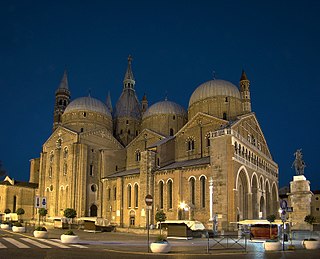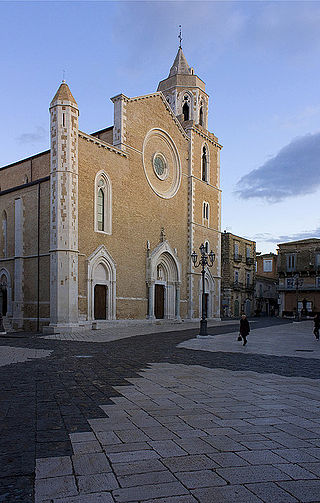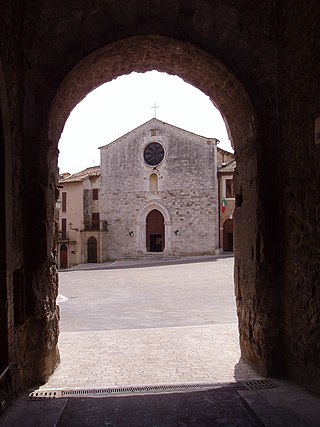
The Basilica of San Petronio is a minor basilica and church of the Archdiocese of Bologna located in Bologna, Emilia Romagna, northern Italy. It dominates Piazza Maggiore. The basilica is dedicated to the patron saint of the city, Saint Petronius, who was the bishop of Bologna in the fifth century. Construction began in 1390 and its main facade has remained unfinished since. The building was transferred from the city to the diocese in 1929; the basilica was finally consecrated in 1954. It has been the seat of the relics of Bologna's patron saint only since 2000; until then they were preserved in the Santo Stefano church of Bologna.

The Basilica of San Frediano is a Romanesque church in Lucca, Italy, situated on the Piazza San Frediano.

Spoleto Cathedral is the cathedral of the Archdiocese of Spoleto-Norcia created in 1821, previously that of the diocese of Spoleto, and the principal church of the Umbrian city of Spoleto, in Italy. It is dedicated to the Assumption of the Blessed Virgin Mary.

Assisi Cathedral, dedicated to San Rufino, is a major church in Assisi, Italy. This stately church in Umbrian Romanesque style was the third church built on the same site to contain the remains of bishop Rufinus of Assisi, martyred in the 3rd century. The construction was started in 1140 to the designs by Giovanni da Gubbio, as attested by the wall inscription visible inside the apse. He may be the same Giovanni who designed the rose-window on the façade of Santa Maria Maggiore in 1163.

Cremona Cathedral, dedicated to the Assumption of the Blessed Virgin Mary, is a Catholic cathedral in Cremona, Lombardy, northern Italy. It is the seat of the Bishop of Cremona. Its bell tower is the famous Torrazzo, symbol of the city and tallest pre-modern tower in Italy.

The Pontifical Basilica of Saint Anthony of Padua is a Catholic church and minor basilica in Padua, Veneto, Northern Italy, dedicated to St. Anthony of Padua.

Padua Cathedral, or Basilica Cathedral of Saint Mary of the Assumption, is a Catholic church and minor basilica located on the east end of Piazza Duomo, adjacent to the bishop's palace in Padua, Veneto, Italy.

Santa Maria del Carmine is a church in Pavia, Lombardy, northern Italy, considered amongst the best examples of Lombard Gothic architecture. It was begun in 1374 by Gian Galeazzo Visconti, Duke of Milan, on a project attributed to Bernardo da Venezia. The construction followed a slow pace, and was restarted in 1432, being finished in 1461.

Pistoia Cathedral, or Cathedral of Saint Zeno is the main religious building of Pistoia, Tuscany, central Italy, located in the Piazza del Duomo in the centre of the city. It is the seat of the Bishop of Pistoia and is dedicated to Saint Zeno of Verona.

Pavia Cathedral is a church in Pavia, Italy, the largest in the city and seat of the Diocese of Pavia. The construction was begun in the 15th century on the site of two pre-existing Romanesque, "twin" cathedrals. The cathedral houses the remains of St. Sirus, first Bishop of Pavia, and a thorn purported to be from the Crown of Thorns worn by Christ. The marble facing of the exterior was never completed.

St. George's Church, Sélestat, is a Gothic church in Sélestat, Bas-Rhin, Alsace, France. The church, of exceptional size and quality, is near the Humanist Library, which was founded in 1452 by Jean de Westhuss, priest at the church of St. George's. Originally dedicated to the Blessed Virgin Mary, the church has been named after Saint George since 1500 and is famous for its Christmas trees hung since 1521

Montisi is an Italian village in the municipality of Montalcino, Province of Siena, Tuscany. It sits on a hill on the boundary between the Val d'Orcia and the Crete Senesi.

Cathedral of Saint Mary of the Assumption in Ruvo di Puglia is a Roman Catholic cathedral in Ruvo di Puglia, an historic and a City of Art in Apulia, southern Italy, dedicated to the Assumption of the Virgin Mary. Formerly the episcopal seat of the Diocese of Ruvo, it is now a co-cathedral in the Diocese of Molfetta-Ruvo-Giovinazzo-Terlizzi. The building is an important example of late Apulian Romanesque architecture, built between the 12th and 13th centuries, with several later alterations.

Lucera Cathedral is the cathedral of Lucera, Apulia, Italy. The dedication is to the Assumption of the Virgin Mary but it is also popularly known as Santa Maria della Vittoria from the statue of the Madonna kept here. It is the seat of the Bishop of Lucera-Troia, and is also a minor basilica. In its present form it originates mostly from the 14th century. It is one of the very few buildings in Apulia in which the Gothic architectural style of the medieval French rulers appears almost unaltered.

The Abbey of Santa Giustina is a 10th-century Benedictine abbey complex located in front of the Prato della Valle in central Padua, region of Veneto, Italy. Adjacent to the former monastery is the basilica church of Santa Giustina, initially built in the 6th century, but whose present form derives from a 17th-century reconstruction.

The Basilica of San Fedele in Como is located in the city center. The present Romanesque church dates from 1120 and is dedicated to the Fidelis of Como.

Santa Maria Maggiore is an ancient Romanesque basilica church located at the foot of Colle di San Pietro in Tuscania, Province of Viterbo, Region of Lazio, Italy. Atop the hill is the Basilica of San Pietro.

Avellino Cathedral is a Roman Catholic cathedral dedicated to the Assumption of the Virgin Mary and Saint Modestinus in Avellino, Campania, Italy. It is the seat of the bishops of Avellino.

The church dedicated to saint Francis of Assisi, known for centuries as San Francesco Grande is a religious building on the Via San Francesco, previously overlooks the Contra porteghi high in Padua, Italy. Through the efforts of Baldo de Bonafarii and Sibilla de Cetto, the convent of the Friars Minor and the Hospital of Saint Francis, Major, operated until 1798.

San Francesco is a Gothic-style, Roman Catholic, church in a piazza of the same name in the town of San Gemini, region of Umbria, Italy. The 13-14th-century church was erected by the Franciscan order and dedicated to St Francis, who visited the town at least twice in his lifetime.






















